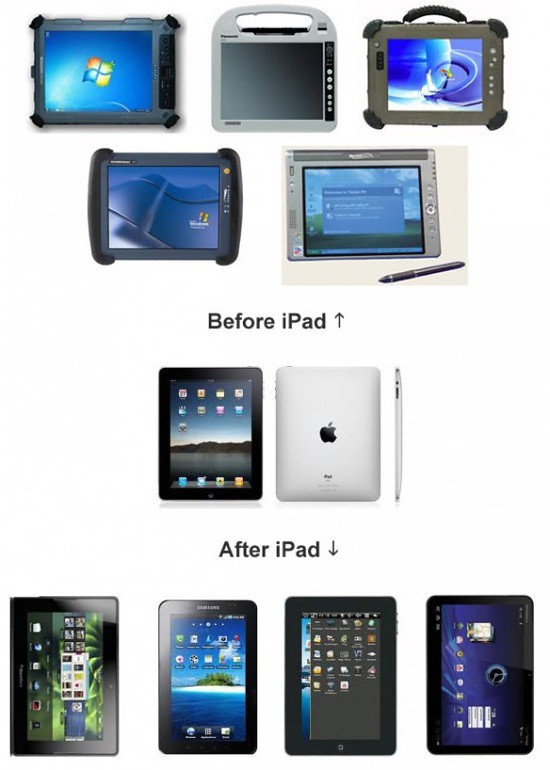Hewlett-Packard this week announced a fundamental shift to its business model this week when it acquired Autonomy for $11.7 billion and announced its plan to axe all of its WebOS products and perhaps spin off its PC business.
That said, the HP TouchPad is now another iPad competitor that’s seen an early death – which really isn’t that surprising given that HP was blindly following Apple into territory it was ill-equipped to traverse. Indeed, that’s a problem most companies have. Instead of working to their strengths and innovating independently, they simply follow Apple’s lead.
Case in point: Check out what tablet computers looked like before the iPad and what tablets look like post-iPad.






August 20th, 2011 at 6:43 pm
Wow conformity!
But some of the pre iPad designs were OK with inbuilt protection.
August 23rd, 2011 at 1:58 pm
looks the same to me…all are square screen that you interact with….Samsung should win
August 23rd, 2011 at 2:28 pm
those android tablets are sideways.
August 24th, 2011 at 5:40 am
My iPad 2 looks remarkably like my 2007 Samsung LCD TV.
August 24th, 2011 at 7:17 am
Yep, interesting how you showed all the pre-ipad tablets in landscape and the post ipad tablets in portrait mode just to make them look more ipad-like. And you also left off the host of other tablets that looked more like the ipad before the ipad and the many post ipad tablets that look nothing like it.
August 24th, 2011 at 7:34 am
So the Archos 5 doesn’t count?
August 25th, 2011 at 3:32 am
You missed the Crunchpad mock ups from 2008. You know, two years prior to the ipad
http://techcrunch.com/2008/07/21/we-want-a-dead-simple-web-tablet-help-us-build-it/
August 26th, 2011 at 2:51 am
@Bugma
Yes, however the Crunchpad design references the MacBook Air, so it was influenced by Apple design even if it was pre-iPad.
August 29th, 2011 at 9:30 am
@gm
Obvious incremental changes are not patentable. If you’re patenting a design, than ANY prior art, even prior art influenced by something you might own, has the potential to invalidate your patent. If the design choice is obvious or someone else can show they made it before you, then you lose your patent.
That’s the core of Samsung’s argument — not that “our tablet looks nothing like an iPad,” but rather that “the iPad design was the obvious next step in tablet design that everyone was naturally coming to anyway.” While you might disagree, plenty of people think that’s a true statement.
“We made it smaller” isn’t patentable, when everyone was already working to make them smaller (the specific details of HOW you make it smaller might be, however).
“Make it rectangular” isn’t patentable, when they were all rectangular already.
“We took off most of the buttons” is hardly patentable, when there are plenty of examples of tablets with few or no buttons, even if they were not as common.
What’s left? “We made it black!” “We put our logo on the back!”
Yes, the iPad is a cool design. When I saw one for the first time, I thought “THIS is what I’ve wanted all along — it’s exactly like I imagined from ST:TNG!” Apple was clearly the first to get it right, but it was merely the design everyone had been trying to get to all along.
So patent the manufacturing process that creates it, or the specific hardware/software inside, or whatever innovations they made to make it possible. But no, the design itself should not be patentable, other than things like the logo — the design was already out there.